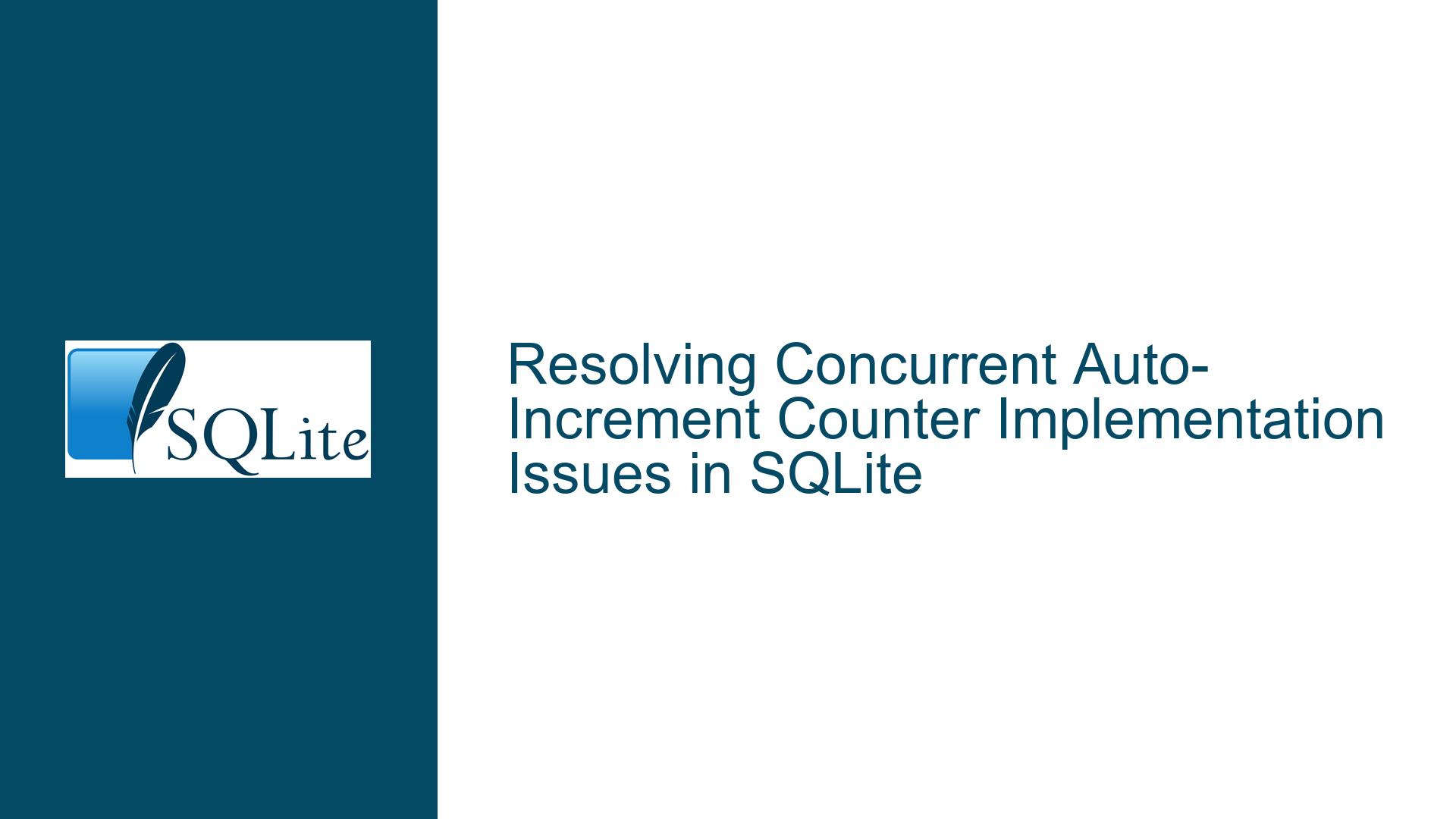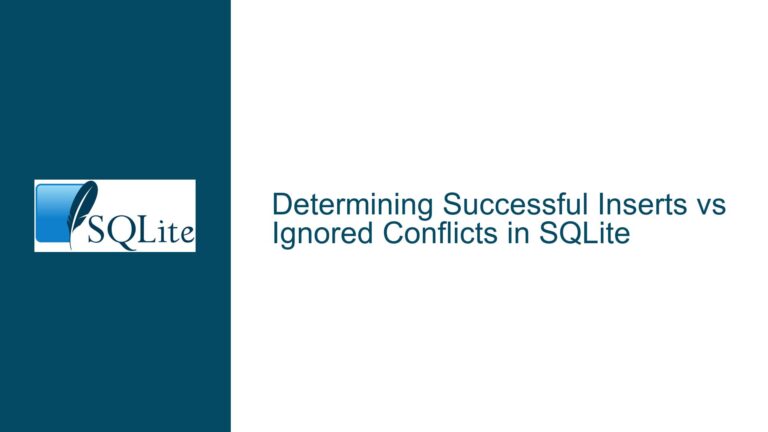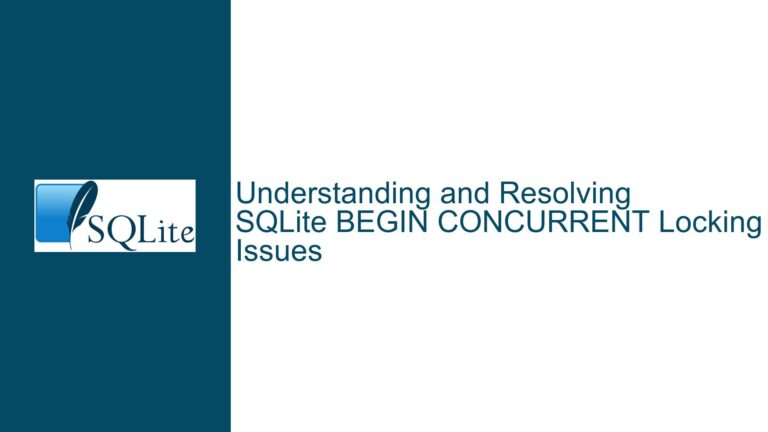Resolving Concurrent Auto-Increment Counter Implementation Issues in SQLite
Issue Overview: Atomic Counter Generation with Thread Safety and Returned Values
The core challenge discussed in the thread revolves around implementing a thread-safe auto-incrementing counter mechanism in SQLite that guarantees uniqueness across concurrent operations while returning the generated value(s) to the application layer. The problem arises in multi-threaded applications where multiple database connections may attempt to read, increment, and write counter values simultaneously. Traditional approaches using triggers or simple MAX(value)+1 logic face critical concurrency risks, including race conditions and duplicate values, due to SQLite’s locking mechanisms and transaction isolation levels.
Key requirements include:
- Atomic Operations: The counter increment must occur as an indivisible unit to prevent interleaved updates from multiple threads.
- Thread Safety: Concurrent connections must not overwrite each other’s counter updates.
- Value Return: The application must immediately know the assigned counter value(s) after insertion/update.
- Avoidance of Exclusive Transactions: Heavyweight
EXCLUSIVElocks should be minimized to maintain performance.
The initial solution proposed uses an AFTER INSERT trigger to calculate the next counter value via SELECT MAX(value)+1. While functional in single-threaded scenarios, this approach fails under concurrency because the trigger’s SELECT MAX query does not lock the table, allowing simultaneous transactions to read the same MAX(value) before either writes its incremented value. This results in duplicate counters. Additionally, triggers execute after the initial insert operation, making it impossible to return the generated value directly to the application without a subsequent query.
Possible Causes: Concurrency Gaps in Trigger-Based Counters and Missing Atomicity
1. Non-Atomic MAX()+1 Logic in Triggers
The trigger’s UPDATE kv SET value=(SELECT coalesce(max(value),0)+1 FROM kv) introduces a read-modify-write cycle that is inherently non-atomic. When two concurrent inserts occur:
- Thread A reads
MAX(value)as 100. - Thread B reads
MAX(value)as 100 before Thread A writes 101. - Both threads attempt to set
value=101, causing a duplicate key violation ifvalueis unique or silent data corruption otherwise.
2. Absence of Row-Level Locking in SQLite
SQLite uses table-level locks for write operations. While the trigger’s UPDATE acquires a RESERVED lock, the initial SELECT MAX(value) in the trigger operates under a SHARED lock, which allows other connections to read the same MAX(value) simultaneously. This violates the isolation required for safe counter increments.
3. Trigger Execution Timing and Visibility
Triggers execute after the initial INSERT operation but before the transaction commits. However, the RETURNING clause in the INSERT statement cannot access values modified by the trigger because the trigger’s changes are part of the same transaction but occur after the INSERT itself. Thus, the original NULL value (or default) is returned instead of the trigger-generated value.
4. Missing RETURNING Clause Support in Older SQLite Versions
The RETURNING clause, essential for retrieving modified values in a single statement, was introduced in SQLite 3.35.0 (2021-03-12). Applications using older versions cannot leverage this feature, forcing developers to use separate SELECT queries, which reintroduce concurrency risks.
5. Improper Connection Handling in Multi-Threaded Environments
SQLite connections are not thread-safe by default. Even with FullMutex enabled (via SQLITE_OPEN_FULLMUTEX), improper use of connections across threads (e.g., sharing a single connection) can lead to undefined behavior. Each thread must use its own connection with appropriate locking.
Troubleshooting Steps, Solutions & Fixes: Implementing Thread-Safe Counters with Atomic Operations
Solution 1: Single-Statement Counter Updates Using RETURNING
For applications using SQLite ≥3.35.0, the RETURNING clause provides an atomic way to increment and retrieve counters. This approach eliminates triggers and uses a dedicated table for counter storage:
-- Config table for counters
CREATE TABLE IF NOT EXISTS config (
name TEXT PRIMARY KEY,
value INTEGER NOT NULL DEFAULT 0
);
-- Initialize counter if missing
INSERT INTO config (name, value) VALUES ('customer_id', 0)
ON CONFLICT (name) DO NOTHING;
-- Atomic increment and return
UPDATE config
SET value = value + 1
WHERE name = 'customer_id'
RETURNING value;
Mechanism:
- The
UPDATEstatement atomically increments the counter and returns the new value. - SQLite’s atomic write operations ensure that concurrent updates are serialized, preventing race conditions.
- The
RETURNINGclause eliminates the need for a follow-upSELECT.
Concurrency Handling:
- SQLite implicitly wraps the
UPDATEin a transaction with anEXCLUSIVElock, ensuring no two connections can modify the counter simultaneously. - Applications must handle
SQLITE_BUSYerrors by retrying the operation, though this is rare with properly configured busy timeouts.
Bulk Allocation:
For reserving a range of values (e.g., allocating 100 IDs at once):
UPDATE config
SET value = value + 100
WHERE name = 'customer_id'
RETURNING value - 99 AS start_id, value AS end_id;
Solution 2: Insert-Time Counters with Trigger-Protected Uniqueness
When unique counters must be generated at row insertion (rather than via a central counter), use a trigger with a uniqueness constraint and retry logic:
CREATE TABLE invoices (
id INTEGER PRIMARY KEY,
invoice_number INTEGER UNIQUE,
-- other fields
);
CREATE TRIGGER assign_invoice_number AFTER INSERT ON invoices
WHEN NEW.invoice_number IS NULL
BEGIN
UPDATE invoices
SET invoice_number = (
SELECT coalesce(MAX(invoice_number), 0) + 1
FROM invoices
)
WHERE id = NEW.id;
END;
Limitations:
- Not thread-safe: Concurrent inserts may calculate the same
MAX(invoice_number). - Workaround: Combine with a
UNIQUEconstraint and retry failed inserts:
# Python-like pseudocode with retry logic
def create_invoice():
while True:
try:
cursor.execute("INSERT INTO invoices DEFAULT VALUES RETURNING id, invoice_number;")
return cursor.fetchone()
except sqlite3.IntegrityError:
continue
Drawbacks:
- Retries degrade performance under high concurrency.
- The
UNIQUEconstraint ensures correctness but shifts concurrency handling to the application layer.
Solution 3: Hybrid Approach with Preallocated Counters
For high-throughput systems, preallocate counter ranges to minimize database contention:
-- Allocate a chunk of 1000 IDs
UPDATE config
SET value = value + 1000
WHERE name = 'customer_id'
RETURNING value;
-- Application uses IDs from (returned_value - 999) to returned_value
Advantages:
- Reduces database round-trips by allocating blocks of IDs.
- Threads can generate IDs locally within their allocated range without further database interaction.
Best Practices for Thread Safety and Connection Management
- Per-Thread Connections: Each thread must open its own database connection with
SQLITE_OPEN_FULLMUTEXto enable safe concurrent access. - Busy Timeout Configuration: Set a busy timeout to handle
SQLITE_BUSYerrors gracefully:sqlite3_busy_timeout(db, 5000); // Wait up to 5 seconds before returning BUSY - Avoid AUTOINCREMENT for Custom Counters: SQLite’s
AUTOINCREMENTkeyword ensures monotonically increasingROWIDs but does not prevent gaps and is unsuitable for user-facing counters. - Use WAL Mode: Write-Ahead Logging (WAL) mode allows concurrent reads and writes, improving performance in multi-threaded environments:
PRAGMA journal_mode=WAL;
Critical Analysis of the Trigger-Based Approach
The trigger method proposed initially fails under concurrency because:
- Non-Atomic Read-Modify-Write Cycle: The
SELECT MAX(value)and subsequentUPDATEare separate operations, allowing interleaved writes. - Lack of Isolation: Concurrent transactions see uncommitted changes only if using
READ UNCOMMITTED, which SQLite does not support by default.
Fix: Replace the trigger with an atomic UPDATE...RETURNING on a dedicated counter table, as shown in Solution 1.
Handling Legacy SQLite Versions (<3.35.0)
For environments where upgrading SQLite is impossible, use a combination of:
- Explicit Transactions:
BEGIN EXCLUSIVE; INSERT INTO kv (name) VALUES ('invoice'); SELECT value FROM kv WHERE name = 'invoice'; COMMIT; - Application-Level Locking: Implement mutexes or semaphores in the application to serialize counter access.
Conclusion
The optimal solution depends on SQLite version and concurrency requirements:
- SQLite ≥3.35.0: Use
UPDATE...RETURNINGon a dedicated counter table for atomic increments and immediate value return. - Legacy Versions: Implement explicit
EXCLUSIVEtransactions or application-level locking, accepting the performance trade-offs. - Insert-Time Counters: Use triggers with uniqueness constraints and retry logic, recognizing the limitations under high concurrency.






